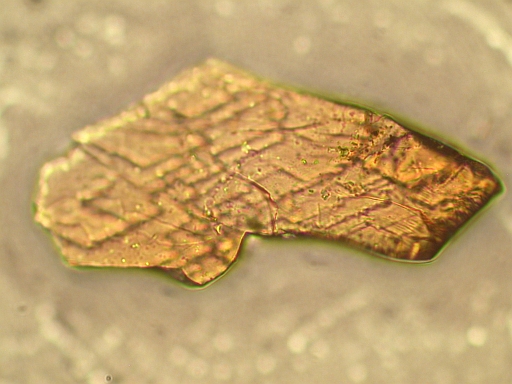Ophirite, Ca2Mg4[Zn2Mn3+2(H2O)2(Fe3+W9O34)2]•46H2O,
a new mineral with a heteropolytungstate
tri-lacunary Keggin anion.
Kampf
AR,
Mineral Science Department, Natural History Museum of Los Angeles County
900 Expositoin Boulevard, Los Angelels,
California 90007, USA
Hughes JM
Department of Geology,
University of Vermont, Burlington, VT 05405,
U.S.A.
Wright SE
Department of Statistics
Miami University, Oxford, OH 45056, USA
Nash BP
Department
of Geology and Geophysics
University of Utah, Salt Lake City, UT 84112, USA
Rossman
GR
Division
of Geological and Planetary Sciences, California Institute of
Technology,
Pasadena,
California 91125-2500, USA
Marty J
5199 E. Silver Oak Rd.
Salt Lake City, UT 84108, U.S.A.
Abstract
Ophirite, Ca2Mg4[Zn2Mn3+2(H2O)2(Fe3+W9O34)2]•46H2O,
is a new mineral species from the Ophir Hill Consolidated mine,
Ophir
District, Oquirrh Mountains, Tooele County, Utah, U.S.A. Crystals of
ophirite
are orange-brown tablets on {001} with irregular {100} and {110} bounding forms; individual crystals are up
to about 1
mm in maximum dimension and possess a pale orange streak. The mineral
is
transparent, with a vitreous luster; it does not fluoresce in short- or
long-wave ultraviolet radiation. Ophirite has a Mohs hardness of
approximately
2 and brittle tenacity. No cleavage or parting was observed in the
mineral. The
fracture is irregular. The density calculated from the empirical
formula using
the single-crystal cell data is 4.060 g•cm-3. Ophirite is
biaxial (+)
with a 2V angle of 43(2)º. Indices of
refraction for ophirite are α 1.730(3), β 1.735(3), γ 1.770(3). The optic orientation
(incompletely determined) is Y
^ b ≈
9° and one optic axis is approximately perpendicular to {001}. Dispersion
r > v, strong; pleochroism is X = light
orange brown, Y = light orange brown,
Z = orange brown; X < Y
<< Z. Chemical analyses of ophirite were obtained
by electron probe microanalysis; optimization of that
analysis using the
results of the crystal structure analysis yielded the formula
(Ca1.46Mg0.50Zn0.04)Σ2.00
(Mg3.96Mn3+0.04) Σ4.00
[(Zn1.16Fe3+0.68Ca0.14Sb5+0.02)Σ2.00
(Mn3+1.42Sb5+0.32Fe3+0.24W0.02)Σ2.00
[(H2O)2((Fe3+0.80Sb5+0.11Ca0.07Mg0.02)Σ1.00(W8.71Mn3+0.29)
Σ1.00)2]]•46H2O; the simplified formula of
ophirite
is Ca2Mg4[Zn2Mn3+2(H2O)2(Fe3+W9O34)2]•46H2O.
Ophirite is triclinic, P
, with a 11.9860(2), b 13.2073(2), c 17.689(1) Å, α 69.690(5), β 85.364(6), γ 64.875(5)° , V 4647.2(4) Å3,
and Z = 1. The strongest four lines in the diffraction
pattern are [d in Å(I)(hkl)]:
10.169(100)(100,110), 11.33(91)(011,010), 2.992(75)(334,341,
5), and
2.760(55)(412,006
3 5). The
atomic arrangement of ophirite was solved and refined to R1
= 0.0298 for 9,230 independent reflections. The structural unit,
ideally
{[6]Zn2[6]Mn3+2(H2O)2([4]Fe3+[6]W6+9O34)2}12-,
consists of a [Zn2Mn3+2(H2O)2]
octahedral layer sandwiched between opposing heteropolytungstate
tri-lacunary ([4]Fe3+[6]W6+9O34)
Keggin anions. Similar structures with an octahedral layer
between two
tri-lacunary Keggin anions are known in synthetic phases. Charge
balance
in the ophirite structure is maintained by the {[Mg(H2O)6]4[Ca(H2O)6]2•10H2O}12+
interstitial unit. The interstitial unit in the structure of
ophirite is
formed of two distinct Mg(H2O)6 octahedra and a
Ca(H2O)6O1
polyhedron, as well as five isolated water molecules. The linkage
between the
structural unit and the interstitial unit results principally from
hydrogen
bonding between oxygen atoms of the structural unit with hydrogen atoms
of the interstitial
unit. Ophirite is the first known mineral to contain a lacunary defect
derivative of the Keggin anion, a heteropolyanion that is well-known in
synthetic phases. The new mineral is named ophirite to recognize its
discovery
at the Ophir Hill Consolidated mine, Ophir District, Oquirrh Mountains,
Tooele
County, Utah, U.S.A.

Plate of ophirite
Last updated 17-Dec-2013
